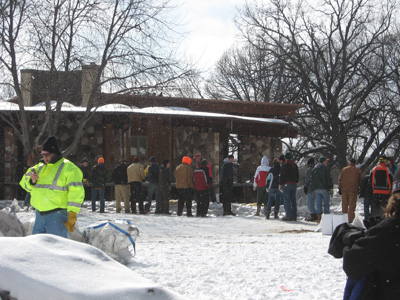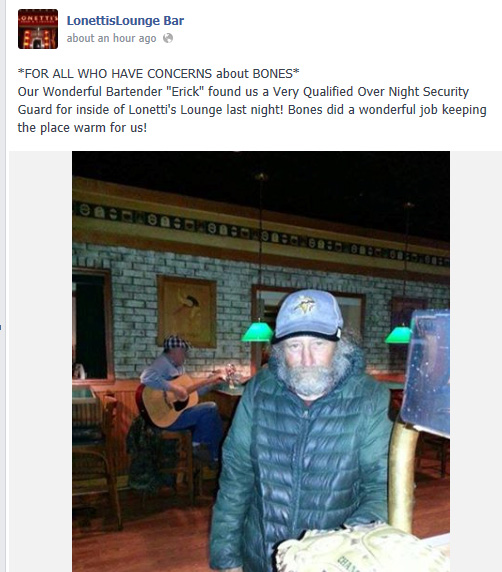1) KEEPING WATCH OVER ONE ANOTHER
People of Saint Paul look out for Bones, an iconic institution on Rice Street. Bones, Mike Hartzell by name, is homeless and patrols Rice Street, helping out where he can, cleaning up the sidewalks, causing no harm, and making more friends than a lot of people have.
The people who watch out for Bones even set up a Facebook page for him last year. In the heat of the summer, people would stop and give him water and ice.
And in the cold?
A lot of people were concerned about Bones when the temperature hit -25 for the last couple of nights. So one location made him a security guard for the night.
2) THE COLD REALITY OF MINNESOTA
It was only 14 below zero this morning when I took the Blog Dog on her daily walk. That’s 12 degrees warmer than yesterday (I have no idea what the wind chill is or was), and the kind of increase that warms a cold heart. The worst of the cold wave is over. We made it through. Pass it on.
In 10 minutes you could be dead without the proper clothes. — Mayor of Minneapolis on their -40 degree weather
— CBS This Morning (@CBSThisMorning) January 7, 2014
The easing of the cold wave comes just in the nick of time. This morning, a TV reporter showed how cold it was by putting a can of Diet Coke on the ground and watching what happens. Some minutes later, the video showed that it fell over, proving — again — that it’s cold. Perhaps, you’ve heard.
Some people actually had fun with it.
After a week of build-up, the cold snap was everything we were told it would be — cold. But what choice did we have other than to adapt and adjust to that fact?
In his column in the Star Tribune today, Jon Tevlin calls those who didn’t cower, “phony tough guys.”
Wussies.
You know what they called this kind of weather back in my day?
Spring break.
When I was a kid, a Polar Vortex was a brand of snow machine, which we only used when it got to say, twice this cold. Otherwise we walked uphill and backward against the wind both ways to school, which never, ever closed.
News item: Minnesota this week was colder than Antarctica, colder than Mars.
For those of us in the media, it’s easy to sit in a cubicle and assume the people we serve aren’t the brightest bulbs in the package; it’s a hazard of the news industry, and it explains why we often sound like everyone’s mother telling you not to run with scissors, over and over again until you want to stab yourself.
There’s a difference, however, between fearing what Minnesota weather has to offer, and respecting it.
This was never more clear to me than the transformative week I spent in Moorhead during the Red River flooding of 2009, when I spent the time with three families desperately trying to save their homes. Armed with good data, they began building the dikes that ringed the neighborhood. And when the prediction for the crest changed — to a foot higher — they built the dikes higher. Then a blizzard came, so they put on hats and coats and boots, and kept building. And the prediction changed again. So they added another foot to the dikes. And they saved their neighborhood.

In that week, I never heard one complaint. The people separated the hype from the data and did what they had to do. They didn’t waste time posting cellphone screenshots to social networks, debating who was taking the threat more seriously, or wag fingers at each other. They didn’t ignore the threat, either. They simply adjusted to the reality of the danger before them , and went on accordingly.
There was nothing phony about them.
It took the Washington Post to assess the situation in Minnesota, and ignore the hysteria.
“It’s just another day,” said Bob Anderson, mayor of International Falls, the northern Minnesota town nicknamed “Icebox of the Nation,” where temperatures reached 30 below zero early Monday. “We know this is going to be part of our winter, and we prepare for it.”
Preparation means spending part of each fall making sure car batteries are in good shape, furnaces are tuned up and pipes are insulated. After that, Anderson said, life proceeds pretty much as normal.
He attended a wedding reception and a memorial service over the weekend, and hundreds of people came for each. The movie theater was packed. Candidates arrived to interview for an open city administrator job at City Hall on Monday morning.
But even Anderson acknowledged that not every part of life can continue as usual. “You’re not going to go outside when it’s 30 or 40 below and go skiing,” he said. “You wait until it warms up to about zero.”
The weather threat is easing and the only story left to do is the one that rarely gets done: Minnesotans knows how to take a punch.
Related: What Happens to All the Salt We Dump On the Roads? (Surprising Science).
Awful pictures of what frostbitten fingers look like (Pioneer Press).
13 Photos That Prove Cold Weather Makes People Crazy (Mashable).
3) BEHOLD, MINNESOTA! THE DRIVERLESS CAR. OR NOT.
Minnesota might be planning too much road expansion, Joe Loveland at streets.mn writes. And there might be a flaw in the 20-year plan, he says, because it doesn’t account for driverless cars:
While we would still need roads in the era of driverless cars, we might need much less road capacity, and different kinds of road capacity.
Both because of fewer crashes and vehicles that can follow each other more closely at higher speeds, we might need much less road capacity to serve travel demand. How much less? Patcharinee Tientrakool of Columbia University estimates that autonomous vehicles could improve capacity by 43%. Driverless vehicles that can coordinate with other driverless vehicles would increase capacity by 273%.
Adeel Lari, a transportation expert and former MnDOT leader who is now at the University of Minnesota’s Humphrey School of Public Affairs, points out that in the 1960s traffic engineers were taught that highway capacity maxed out at around 2,000 vehicles per lane per hour. With improved traffic management methods and technology, Lari and his MnDOT colleagues later found they could briefly push capacity as high as 2,600 vehicles per lane per hour.
Temporarily moving from 2,000 to 2,600 vehicles per lane per hour was a huge improvement. But driverless cars could push capacity to a jaw-dropping 6,000 vehicles per lane per hour or higher, which Lari calls a “game changer.”
This is what we’ve come to.
It’s Texas (surprise!). The Esquire network is premiering Friday Night Tykes that documents a football league where the kids are all under age 10, the Los Angeles Times says.
“The trailer is definitely troubling to watch,” an NFL spokesman said, adding that the league being shown in “Friday Night Tykes” is not part of its Heads Up Football Program, which seeks to improve player safety in youth football.
An Esquire Network spokeswoman said, “Friday Night Tykes” provides an “authentic and provocative glimpse into an independent youth football league in Texas.” The spokeswoman added, “We believe ‘Friday Night Tykes’ brings up important and serious questions about parenting and safety in youth sports, and we encourage Americans to watch, debate and discuss these issues.”
Related: Chris Kluwe: I was fired for speaking out about same-sex marriage (CNN).
5) CHURCH WITHOUT THE RELIGION?
NPR this morning profiles a Los Angeles meeting of Sunday Assembly, a church for people who don’t believe in God. The brainchild of two British comedians, the movement has since spread across the globe, and there are now about 30 chapters from Dublin to Sydney to New York, NPR says.
“Some people who were raised with religion rejected it for certain reason that leaves them with a bitter taste in their mouth about religion: either they had bad experiences in their church, or they saw hypocrisy in the youth pastor, or they felt that religion was manipulative or all the litany of reasons people might not like religion,” Phil Zuckerman, who teaches about secularism at Pitzer College in Southern California, says. “Those people are a little bit angry at religion.”
BONUS: How a Pothole Repair Crew Helped Land a Plane on a Bronx Highway (The Atlantic Cities). (h/t: John Olson)
WHAT WE’RE DOING
Daily Circuit (9-12 p.m.) – First hour: The consequences of oil independence.
Second hour: Fifty reasons to reread books from high school.
Third hour: Cris Beam’s novel The Intimate Life of American Foster Care is included on the New York Times list of 100 Notable books for 2013. Cris Beam was on our program on 10/21/13 talking about her book and conditions of foster care families. We will replay this segment. The second half of the show is a live segment about the kind of support foster care families need to be successful. We’ll look at a few community support models from around the country.
MPR News Presents (12-1 pm) – Live National Press Club: Gen. Ray Odierno, U.S. Army chief of staff. He was commanding general in the Iraq war and will discuss the Al-Qaida linked militia strength in Iraq cities, and other concerns of the U.S. military.
The Takeaway (1-2 p.m.) – A look at the polar vortex.
All Things Considered (3-6:30 p.m.) – American troops ousted Islamist militants from Fallujah and suffered many casualties. Now they see on the news that the Iraqi city is under threat again. Whats it like for them to see Fallujah back under siege after
they fought two major battles for the city? NPR has reactions from U.S. veterans.
Today’s Question
How should Mayor Hodges address disparity in Minneapolis?

